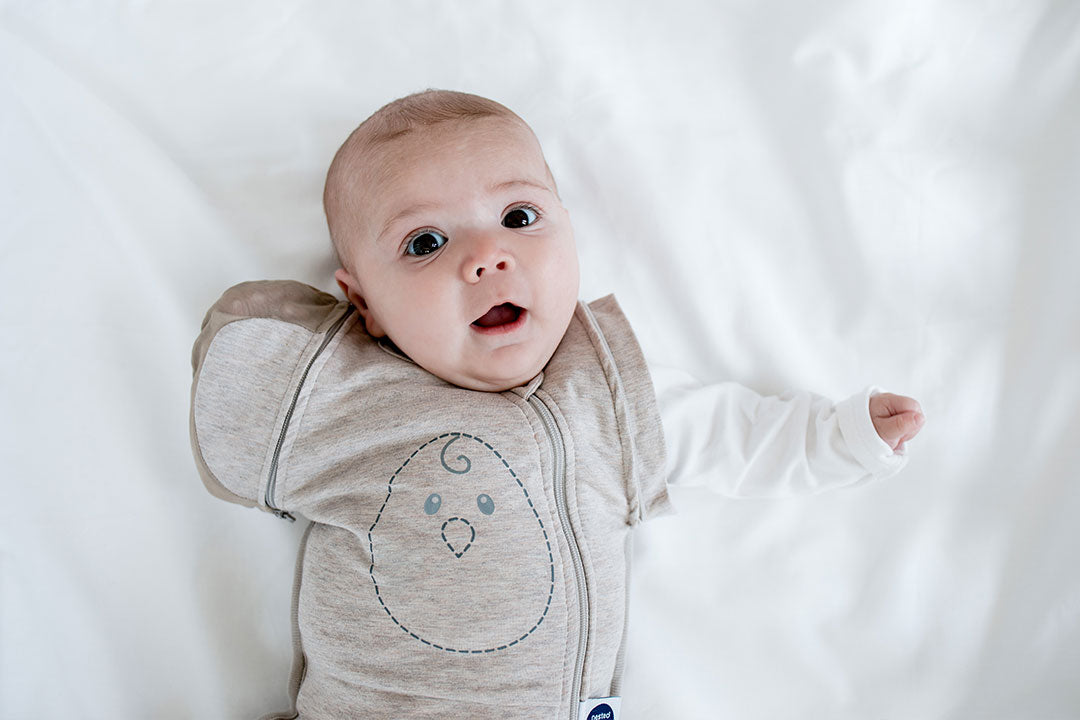Shopping Cart

When do you stop swaddling a baby? This is a question every parent or caregiver is faced with as your child's start reflex starts to fade and they begin to hit certain developmental milestones.
Swaddling is a fantastic way of helping your newborn sleep - parents all over the world have done it for centuries, and even today many moms are sent home from the hospital having been shown how to do it right. In a loud, unfamiliar world, swaddling can help give your baby the same feeling of comfort and security that they had for 40 weeks in the womb.
But despite the countless benefits of swaddling, it can't last forever; like many other aspects of looking after your baby, it has to stop at some point. In the case of swaddling, this is because it can become potentially unsafe once your little one has hit certain developmental milestones.
So, when should you stop swaddling your baby? There is no one size fits all answer - it can be as soon as 2 months old or as late as 4-6 months. The hard part is watching for signs of readiness for the transition out of the swaddle - but don't stress. We're here to help you navigate this tumultuous period.
Many parents are unsure of when they should stop swaddling, and might be anxious to stop if it's been helping their little one sleep - but the transition period doesn't have to be hard if you know what you're getting into!
Before we talk about when to stop swaddling baby, let's talk about why you need to stop in the first place.
Why You Need to Stop Swaddling Your Baby Eventually

We know what you're thinking...swaddling has become your secret weapon in getting your baby to calm down and fall asleep with ease. Why does it have to come to an end?
Swaddling by using the correct techniques - such as keeping your baby on their back and ensuring their hips have enough room - is perfectly safe for your newborn baby. However, once they get to a certain age, you'll need to transition away from the practice.
The AAP (American Academy of Pediatrics) states that you should stop swaddling your baby when they begin to show signs of being able to roll over. This is because it is much more difficult for a swaddled baby who has rolled on their front to move back into a safe position.
So, when do you stop swaddling a baby?
When to Stop Swaddling Baby: How to Determine When It's Time to Make the Transition Out of the Swaddle
Swaddling is comforting and helpful for newborns, especially when they're struggling to sleep through the night, but it’s dangerous for older babies who can break free from their blankets or roll over onto their front. So, when should you stop swaddling your baby?
Being wrapped up can even get in the way of healthy development for older babies since it prevents them from practicing age-appropriate motor skills.
So at what age should you stop swaddling? You’ll want to transition away once your little one becomes more active and starts to try to roll over. This might occur as early as 2 months, but usually happens by around 3 or 4 months - whatever your baby's age, when you see the signs of rolling over, it's time to stop swaddling.
You should also keep in mind that not all babies enjoy being swaddled, and some may become restless quicker than others. For babies like this, it might make sleeping difficult, resulting in many disrupted nights and some seriously tired parents.
So, if you find your little one isn’t happy in the swaddle anymore, don’t feel like you have to wait it out. It’s perfectly fine to stop swaddling your baby before they reach a certain age or begin to break free from the swaddle during the night - what matters is that your baby can fall asleep comfortably and safely.
As each child is unique, it’s essential to look at other indicators (outside of just age) that they’re ready to leave swaddling behind. That’s what we’ll dive into now.
Readiness signs to watch for When to Stop Swaddling a Baby
As always, the best thing to do to know when to stop swaddling baby is to keep a close eye on your baby and their behavior - start with nap time so you can observe the baby's response.
If your baby still shows signs of Moro reflex (also known as startle reflex), is unable to fall asleep, or is still waking up multiple times during longer sleep periods, it might be too early to transition. In this case, you can try swaddling for a little longer (maybe a couple more weeks) and then give it another go.
It is normal for your little one to take a little longer to fall asleep at first as they get used to their newfound feeling of freedom while sleeping, but this should change after a couple of days.
You should ditch the swaddle as soon as you notice your little one becoming more active and attempting to roll over, which can occur as early as 2 months.
Although many babies roll over at around 3 or 4 months old, bidding the swaddle farewell should generally happen earlier on, when your baby starts showing signs of trying to roll.
What makes this the best age to stop swaddling? Once your baby is mobile to the point where they could potentially kick off their blanket, the blanket poses a possible suffocation or strangulation hazard.
Remember: safe sleep rules say no loose blankets or bedding in the crib or bassinet until your baby’s first birthday, at the very earliest, which is why sleep sacks are perfect for this age range.
Additionally, it’s not just a safety issue. Once your baby is getting more mobile, being confined to a wrap can prevent her from practicing age-appropriate motor skills - and that could be bad for her development.
How to transition out of the swaddle when the time comes

If you've become reliant on the swaddle as a way of keeping your fussy baby calm through the night, you might be understandably nervous about letting go.
But you don't have to completely get rid of it right away - in fact, slowly transitioning from a swaddle to a sleep sack is a much smoother process and still safe for your little one. Before we highlight the three steps to transition out of swaddling, let’s address a common question:
Should I go cold turkey when I stop swaddling my baby?
While some babies are perfectly fine without their swaddle and don't need any time to get used to going without it, others might take a little more time - and that's perfectly fine! If your family has relied on the swaddle to keep your baby calm through the night, it isn't easy to give it up, and it might take a week or two for your child to adjust.
To help them along, you can try a more gradual method: start by swaddling your baby with one arm out for a few nights, then move on to both arms out for a couple of nights before replacing the swaddle blanket altogether with something like a sleep sack.
Swaddle with one arm out
You can start your journey towards swaddle-free sleep by wrapping your baby up in the swaddle blanket with one arm out for a few nights - around 3 or 4. Many parents do this anyway if their baby likes to suck their thumb through the night or feels calmer with a little more free movement, and it's a great first step to sleeping without the swaddle.
Swaddle with both arms out
Next, you'll want to move on to swaddling your baby with both arms free for 3 or 4 nights. Though they might not be in the classic baby burrito anymore, they'll still be feeling some of the comfort and womblike snugness the swaddle can provide.
If you aren't sure how to wrap your baby this way, our Zen One swaddle sack could be a lifesaver - with its detachable mesh sleeves, all you need to do is zip them off and your baby is ready for bed!
Transition to a sleep sack
Once your baby has been sleeping arms-free for a few nights, you can move on to the final step - the sleep sack! As your baby is still too little to have a loose blanket with them unsupervised, a sleep sack like our Zen Sack is a safe alternative that can keep them cozy through the night.
You can prepare for this transition by reading our guide on sleep sack vs swaddle,
Ultimately, there’s no one best way to stop swaddling — so do what you think will work best for your baby and you. And if you have any questions, you can always reach out to your baby’s pediatrician for medical advice.
Navigating the Adjustment period
New parents often find that having a baby is full of constant changes and challenges, and alterations to your baby's sleep routine will also take some getting used to — for both you and your baby.
Every baby is unique, which also means that not every baby will take the same amount of time to comfortably transition from a swaddle to a sleep sack. However, it's fair to want to have some idea of how long it might take so you can plan!
In most cases, a baby will begin to adjust to sleeping without a swaddle within a couple of weeks - maybe even within just a few nights if you’re really lucky!
On the other hand, if it's been over four weeks and your little one is still struggling to get to sleep without their trusty swaddle, consult your pediatrician to rule out any other health-related factors that may be affecting their sleep cycle.
Tips for helping baby sleep without a swaddle after making the transition

While some babies might sleep soundly without their swaddle, others might need a little more help getting used to sleeping without one. Here, we've gathered up seven of the best tips and tricks for helping your little one sleep through the night without their swaddle blanket:
Transition gradually
As we've said earlier in this blog, you don't need to stop swaddling completely as soon as your baby hits the rolling milestone, though you'll need to start making some changes for safety reasons. If your baby becomes fussy or upset when they're put to bed without their swaddle, a slower transition period may keep them calm during this confusing time.
To do this, try a few nights swaddling with one arm out, then with both arms out, before removing the swaddle altogether and replacing it with a sleep sack or wearable blanket designed for this new period of their life.
A regular routine
Whenever you're introducing any kind of major change to your baby's sleep routine, whether its stopping swaddling, beginning sleep training, or introducing a new schedule, the important thing is to remain consistent.
This provides them with a sense of security and helps them to create positive sleep associations where they feel safe enough to fall asleep without you there.
A soothing bedtime routine can do wonders for keeping your little one calm at nighttime. Whether it involves a warm bath and a cuddle or just a quick change and a bedtime story, as long as you make sure it's the same each night, it's likely to keep your baby feeling more at ease.
A calm environment
This goes hand in hand with a soothing bedtime routine, and is especially important if you live in a busy city or apartment complex or if you have a larger family who might be making noise at night and keeping your baby awake.
By keeping the room that your baby sleeps in dark and quiet, you'll be preventing them from feeling overstimulated, especially as they don't have the swaddle to keep them tightly tucked in and secure.
To do this, you can try using blackout blinds to block out light from streetlamps and other buildings, and a baby-safe white noise machine to soften any sounds that might be keeping your little one from settling.
Zen Sack

If you're looking for a sleep sack for your little one to wear after they've transitioned away from using a swaddle blanket, we highly recommend our Nested Bean Zen Sack! With its gently weighted Cuddle Pad that mimics your soothing touch, it can provide a similar kind of comfort to a swaddle while keeping your baby safe as they sleep.
See for yourself what a dramatic difference our weighted sleep sack can make in your baby sleep schedule. We also have other styles, like our bamboo sleep sack or winter sleep sack along with a whole range of weighted sleepwear to help you create the comfiest, coziest, and most importantly, safest sleep environment possible.
Try a pacifier
Pacifiers are a classic baby sleep aid for a reason - they help your little one self soothe and satisfy their urge to suck through the night without needing to wake you up for a feeding or a cuddle.
If your baby already uses pacifiers and you've found them to be effective, or if you haven't tried them and think they could help, now might be a good time to let your baby suck on one as they sleep for a little extra comfort.
Infant massage
If you haven't done it before, a baby massage is a great way to calm your baby down before bedtime, as well as a super cute bonding activity.
For a simple massage, try starting by gently rubbing your little one's feet before moving up their legs, tummy, and chest. Then you can work on their arms before finishing with their face (and a little goodnight kiss!). Our guide on baby massage for sleep can help you incorporate this into your child's routine.
Put to bed drowsy
Though you might feel like putting your baby to bed after they've already dozed off is the simpler solution, it might actually create more negative sleep associations going forward where they rely on you to fall asleep.
Instead, try putting them to bed when they're drowsy so that they can fall asleep in the crib themselves. This way, they're more likely to go to sleep in the future without needing you there and might start feeling secure enough to go without their swaddle blanket too!
When to stop swaddling baby: Key Takeaways
When it's time to stop swaddling your baby, you're both likely to feel a little nervous - but with a little prep and a sleep sack, we know you've got this! Just as a quick refresher, here are the key points you need to know about putting away the swaddle blanket:
- You'll need to stop swaddling your baby at around 3 or 4 months old
- The main sign that you need to stop is when your baby starts to roll over
- You should also stop if they're breaking out of the swaddle during sleep
- You can transition over a week or two by letting one arm, then both arms free
- Our Nested Bean Zen One with detachable zip-off sleeves is perfect for this transition
- Some babies might only take a few nights to transition, while others take a couple of weeks
- Keep up a calming bedtime routine during this time to soothe your baby to sleep without the swaddle
If you are struggling to swaddle a fussy baby, or finding that you can't quite get the fit right, then the Zen One could be a lifesaver!
The Nested Bean Zen One classic takes all the guesswork out of swaddling your baby, and features a gently weighted pad to mimic your calming touch and promote self-soothing. It's also designed with removable sleeves to help babies transition away from their swaddles while keeping that cozy, womblike feeling.
Learn more about the Zen One Classic over on the product page. It's our transitional swaddle that parents love. But, it may be worth trying other types of swaddles - like our zipper swaddle or weighted swaddle.
We also have helpful tips in our blog on how to swaddle a baby, what to do when your newborn baby wants hands out of swaddle, more advanced swaddling techniques, reason to swaddle a baby, and more.
At this point, we've covered most of the important information on when to stop swaddling baby. So, let’s bring this conversation to a close with a few parting words.
Wrapping Up Our Guide on When to Stop Swaddling Your Baby
So, when do you stop swaddling a baby? It can happen as early as the 2 month mark or as late as the 4-6 month mark. That's why knowing when to stop swaddling your baby comes down to watching for the telltale signs that your child is ready for the transition out of the swaddle.
While you may be dreading this transition, don't lose hope. With our tips on making the transition smooth and our sleep sacks, you can still get a newborn to sleep on a somewhat regular schedule. Just remember - part of parenting is dealing with the ups and downs. When they're all grown up, you'll wish you had a few more sleepless nights cuddling them by their crib. So, appreciate this transitionary period for what it is!
Hopefully, this conversation on when to stop swaddling baby has provided you with clarity and eased your stress a bit. Take what you've learned today and look for the signs that your child is starting to lose their startle reflex, beginning to roll over, or attempting to break the swaddle wrap. They're growing up right before your very eyes!

